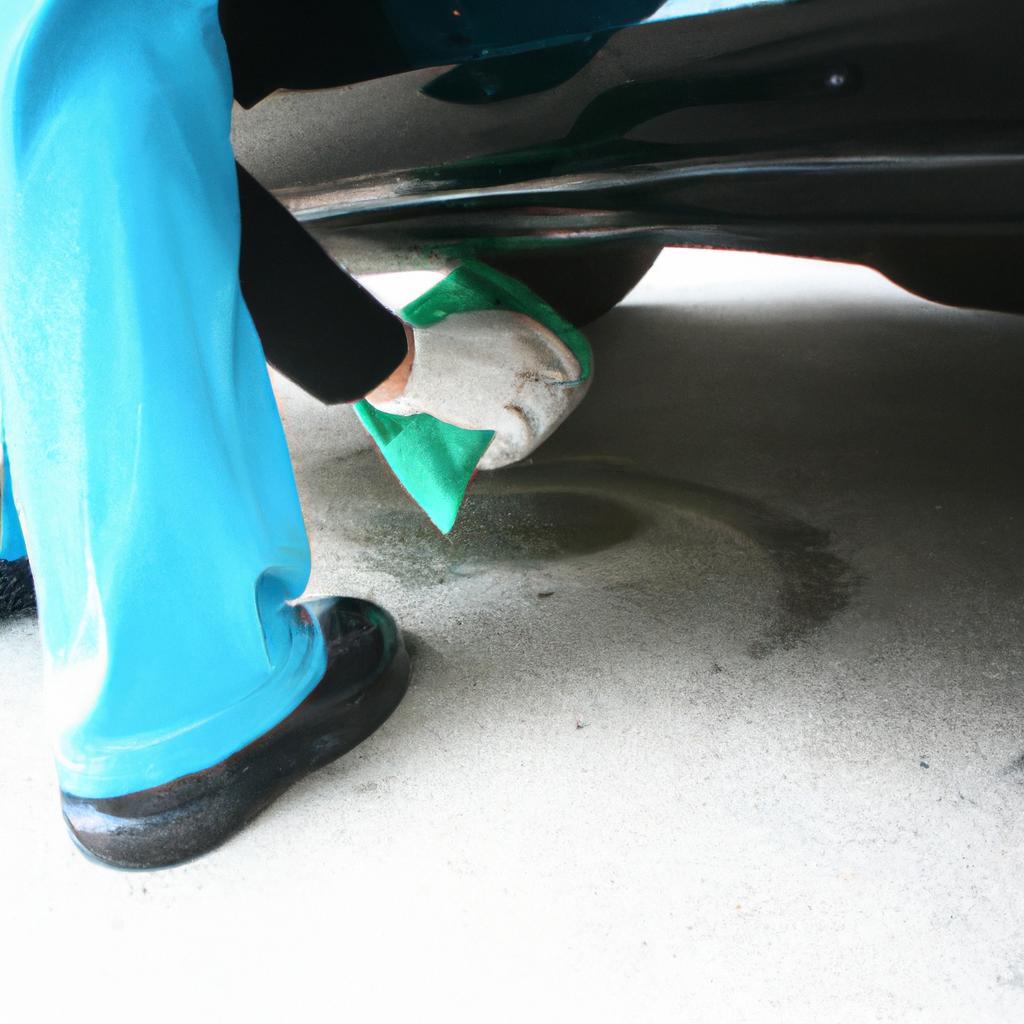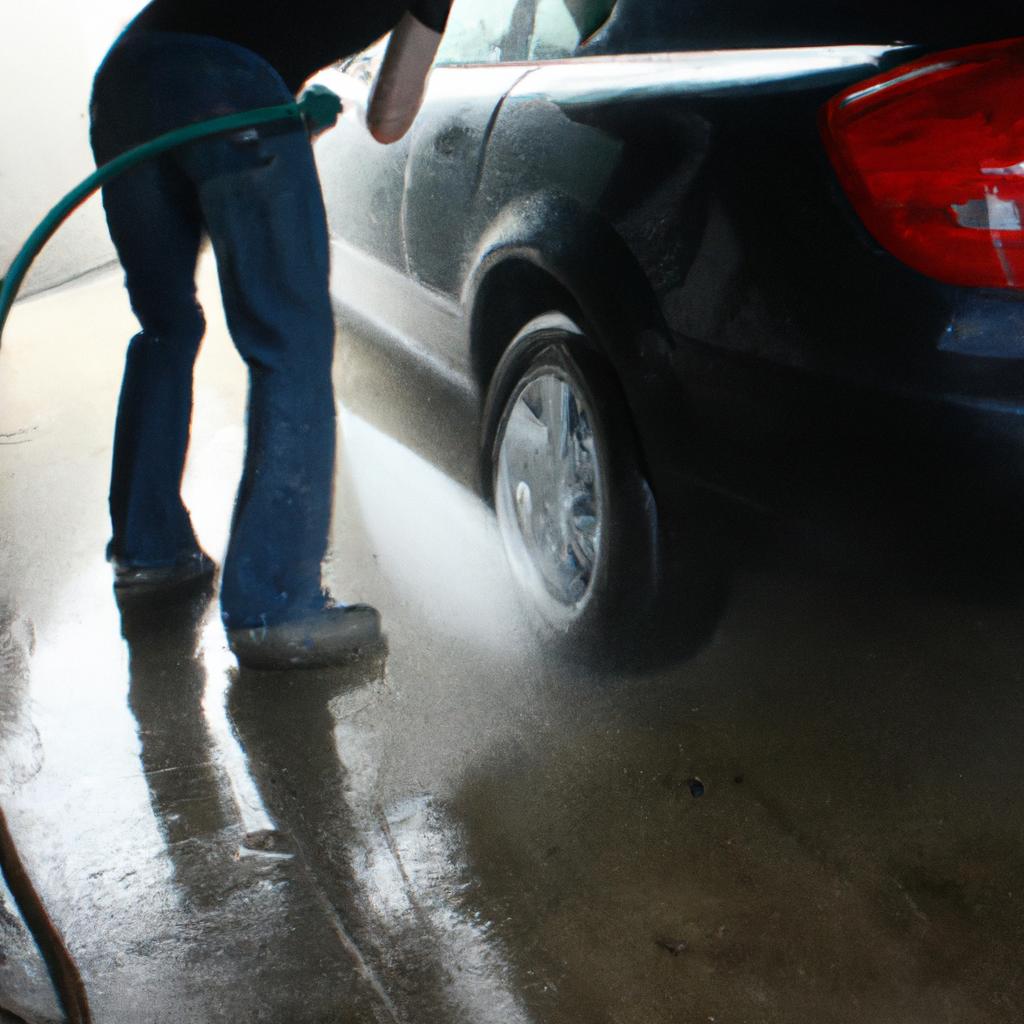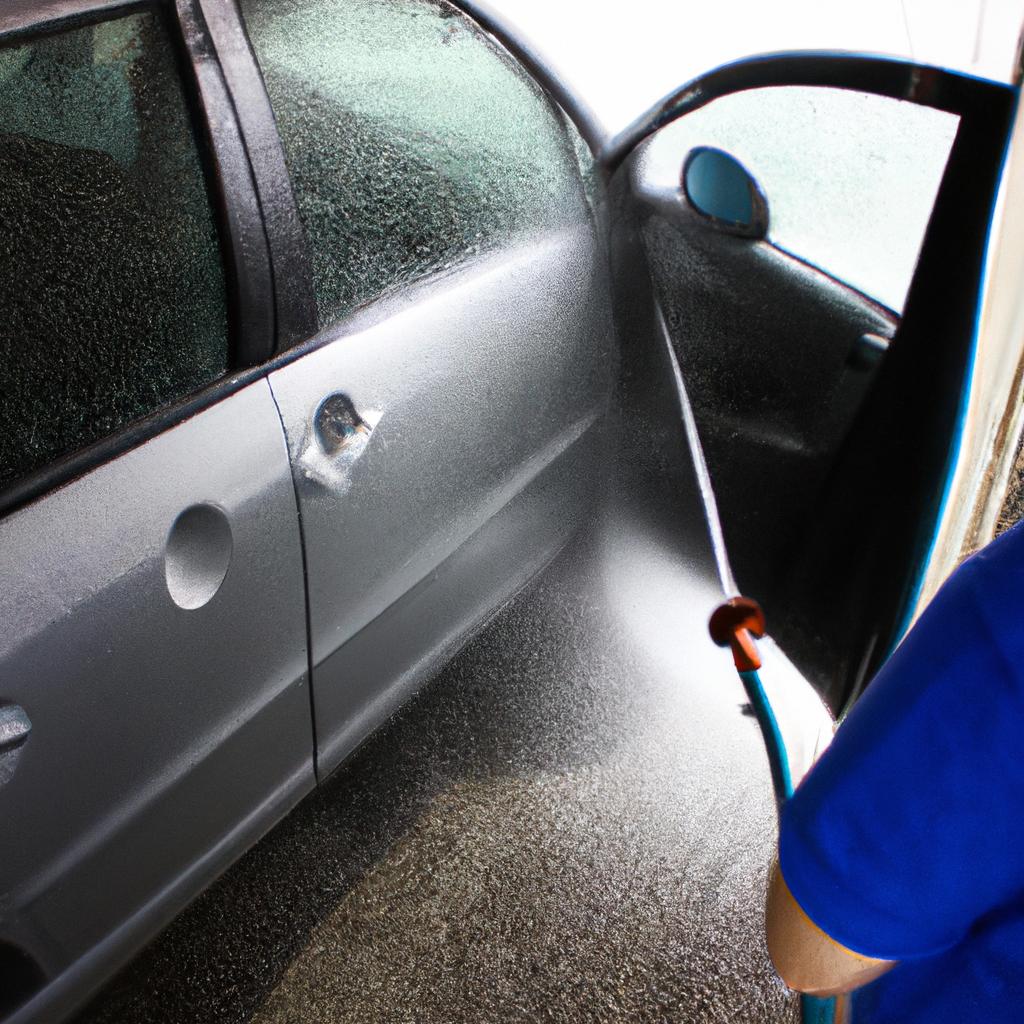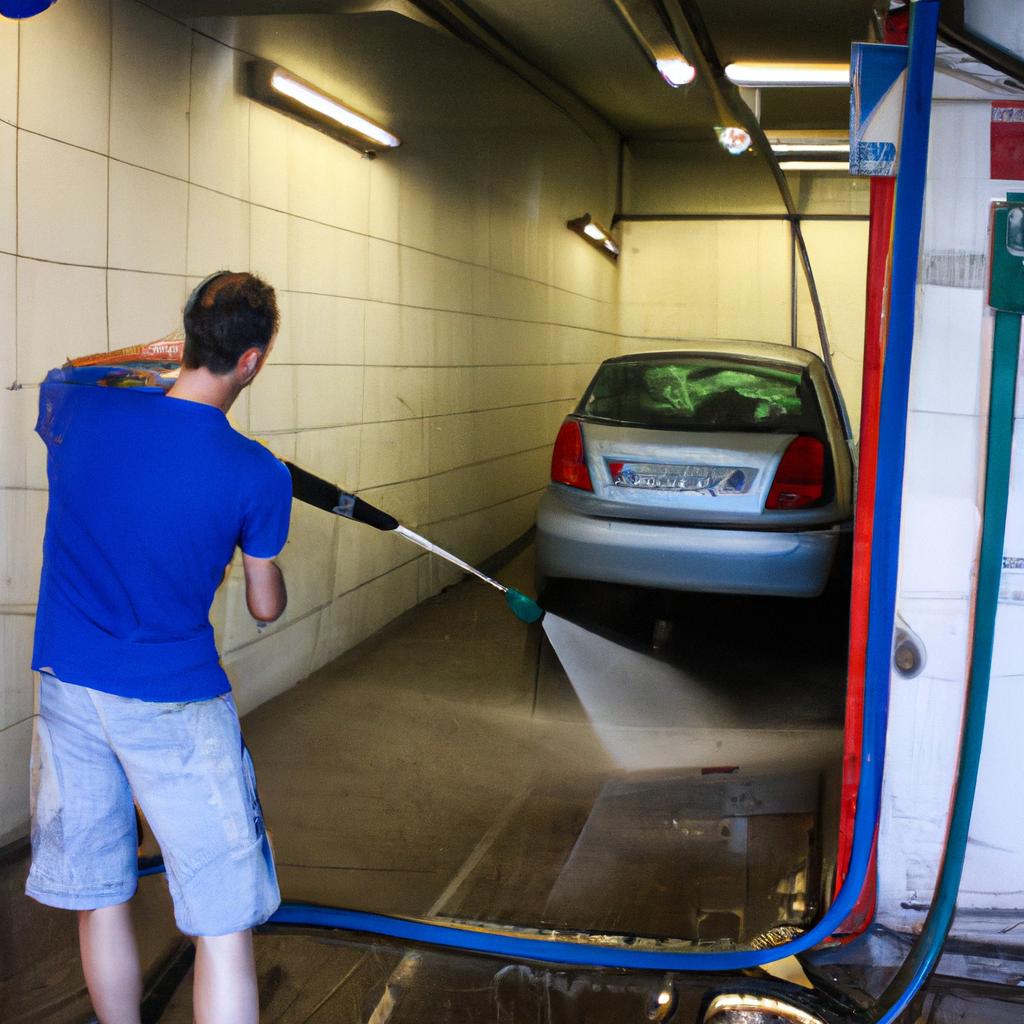Water pressure plays a crucial role in achieving an immaculate underbody wash at car washes. Imagine driving on a muddy road after heavy rainfall, with dirt and debris accumulating underneath your vehicle. As you approach the nearest car wash, eager to restore your vehicle’s cleanliness, it becomes vital to understand how water pressure can effectively remove these stubborn contaminants from the undercarriage. This article explores the significance of water pressure in ensuring a perfect underbody wash in car washes.
In one hypothetical scenario, consider a car that has been driven through rough terrain, accumulating layers of mud and grime beneath its chassis. Without adequate water pressure during the underbody wash phase at the car wash, this accumulation may persist, leading to potential damage over time. The force exerted by high-pressure water jets is essential for dislodging and flushing away deeply embedded dirt particles from hard-to-reach areas such as wheel wells and suspension components. By maintaining optimal water pressure levels throughout the cleaning process, car owners can ensure effective removal of contaminants while preserving their vehicles’ longevity. Thus, comprehending the impact of water pressure on achieving a flawless underbody wash is imperative for every car owner seeking pristine cleanliness and long-term maintenance benefits.
Importance of Water Pressure in Car Washes
Importance of Water Pressure in Car Washes
Car washes have become an essential part of vehicle maintenance, ensuring the cleanliness and longevity of automobiles. Among the various components that contribute to a thorough car wash, water pressure stands out as a crucial factor. Adequate water pressure plays a significant role in achieving a perfect underbody wash by effectively removing dirt, debris, and grime from hard-to-reach areas.
To illustrate the importance of water pressure, let us consider the case study of a luxury sedan subjected to both high and low-pressure underbody washes. In the first scenario, where the high-pressure option is employed, the forceful jets of water penetrate through crevices and dislodge accumulated dirt particles with ease. On the other hand, in the second scenario with low-pressure washing, insufficient force fails to reach hidden nooks and crannies, leaving residual contaminants untouched.
Water pressure directly impacts the effectiveness of an underbody wash due to its ability to remove stubborn substances such as road salt or mud. The following bullet points highlight how adequate water pressure improves this process:
- Enhanced Cleaning: High water pressure provides greater agitation on surfaces, resulting in more effective removal of tough stains.
- Time Efficiency: With sufficient water pressure, less time is required for cleaning as it ensures quick and efficient rinsing.
- Preventive Maintenance: Regular use of proper water pressure can help prevent corrosion caused by accumulation of corrosive materials underneath vehicles.
- Overall Vehicle Appearance: A thorough underbody wash achieved through optimal water pressure contributes to maintaining a pristine appearance while preventing potential damage.
In addition to these benefits, understanding how different levels of water pressure impact specific parts during an underbody wash is equally crucial. This knowledge allows operators at car wash facilities to tailor their services accordingly without causing any harm. Consequently, comprehending how water pressure affects the undercarriage becomes imperative in providing customers with satisfactory results.
Transitioning into subsequent sections, the focus will now shift towards exploring how water pressure affects various aspects of the underbody wash. By delving deeper into this topic, we can gain a comprehensive understanding of its significance in car wash operations and maintenance.
How Water Pressure Affects the Underbody Wash
Water pressure plays a crucial role in achieving a perfect underbody wash in car washes. With the right water pressure, dirt and debris from hard-to-reach areas can be effectively removed, ensuring a thorough cleaning that enhances both the appearance and longevity of vehicles. Let’s explore how water pressure affects the underbody wash in more detail.
One case study that exemplifies the importance of water pressure is a comparison between two different car wash systems: one with high-pressure jets and another with low-pressure sprays. In this study, it was found that the system utilizing high-pressure jets was significantly more effective at removing stubborn grime and contaminants from the undercarriage. The increased force provided by higher water pressure allowed for better penetration into crevices and tight spaces, resulting in a superior clean.
To further emphasize the significance of water pressure in underbody washing, consider these key factors:
- Water velocity: Higher water pressure translates to greater velocity, enabling the removal of tough residues such as mud or road salt. This accelerated flow helps dislodge particles from hard-to-reach areas.
- Cleaning efficiency: Increased water pressure enhances cleaning efficiency by reducing the time required to remove dirt, grease, and other substances from the underside of vehicles. This not only saves time but also improves overall productivity.
- Customer satisfaction: A powerful underbody wash contributes to an enhanced customer experience. When customers see their vehicle undergo a comprehensive cleaning process that includes attention to often-neglected areas like the undercarriage, they feel satisfied knowing their investment is being cared for properly.
- Environmental consciousness: Optimal water pressure ensures minimal wastage while still providing effective results. By minimizing excessive use of resources, car washes can demonstrate environmental responsibility.
Table: Comparative Analysis of High vs Low Water Pressure Systems
| Aspect | High Pressure System | Low Pressure System |
|---|---|---|
| Cleaning Efficiency | Excellent | Adequate |
| Water Velocity | High | Low |
| Customer Satisfaction | High | Moderate |
| Environmental Impact | Minimal wastage | Higher water usage |
By understanding the impact of water pressure on underbody washing, car wash operators can optimize their systems to provide a superior cleaning experience. In the subsequent section, we will explore the various factors that influence water pressure in more detail, allowing for a comprehensive overview of this critical aspect of car wash operations.
Factors That Influence Water Pressure
Water pressure plays a crucial role in achieving a perfect underbody wash in car washes. Now let’s explore some key factors that influence water pressure.
One example of how water pressure impacts underbody washing can be seen when comparing two different car wash systems: one with low water pressure and another with high water pressure. In the case of low water pressure, it may not provide enough force to dislodge stubborn debris from hard-to-reach areas underneath the vehicle. On the other hand, high water pressure ensures stronger jets that can effectively remove even stubborn dirt particles.
To further understand why water pressure is vital for an effective underbody wash, consider these factors:
- Nozzle design: The type and quality of nozzles used greatly affect water pressure. High-quality nozzles are designed to maximize the flow rate while maintaining sufficient pressure.
- Pump capacity: The pump’s ability to maintain consistent and strong water flow also determines overall water pressure during underbody cleaning.
- Water source: The volume and speed at which water is supplied impact the achievable level of pressure. Insufficient supply or slow-flowing sources may result in lower-than-desired pressures.
- Plumbing system: Properly maintained plumbing systems ensure minimal losses in terms of friction and leaks, allowing maximum delivery of pressurized water.
Table 1 below summarizes these factors along with their impact on overall water pressure:
| Factors | Impact on Water Pressure |
|---|---|
| Nozzle design | Maximizes flow rate |
| Pump capacity | Maintains consistent flow |
| Water source | Affects achievable level |
| Plumbing system | Minimizes loss |
This discussion highlights the significance of optimal water pressure for effective underbody cleaning. Achieving ideal levels of water pressure enhances the efficiency and thoroughness of the wash process, leading to a superior cleaning outcome. In the subsequent section, we will delve into determining the optimal water pressure required for underbody cleaning and its associated benefits.
Optimal Water Pressure for Effective Underbody Cleaning
Factors That Influence Water Pressure
Water pressure is a critical component in achieving a perfect underbody wash in car washes. Understanding the factors that influence water pressure can help car wash owners and operators optimize their systems for effective cleaning. This section will explore these factors, providing insights into how they impact the overall washing experience.
One example of a factor that influences water pressure is the type of water pump used in the car wash system. Different pumps have varying capacities and capabilities, which directly affect the level of pressure generated. For instance, high-pressure pumps are designed to deliver forceful streams of water, ideal for removing stubborn dirt and grime from underneath vehicles. On the other hand, low-pressure pumps may be suitable for less demanding applications or when gentler cleaning is required.
Additionally, the diameter and length of pipes within the car wash infrastructure play a vital role in maintaining optimal water pressure. Narrower pipes tend to create higher pressures due to limited space for water flow, while wider pipes allow for better volume distribution but at lower pressures. Careful consideration must be given to strike a balance between pipe diameter and desired water pressure levels.
Moreover, it’s important to monitor any potential obstructions or blockages within the piping system as they can significantly reduce water pressure. Accumulated debris or mineral deposits can impede proper flow and restrict adequate pressure delivery to targeted areas during an underbody wash.
To further emphasize the importance of optimizing water pressure in car washes, consider the following bullet points:
- Higher water pressure ensures thorough removal of dirt and contaminants from hard-to-reach areas.
- Insufficient water pressure may result in incomplete cleaning, leaving behind residues that could lead to corrosion or damage over time.
- Adequate pressure enhances customer satisfaction by delivering visible results and instilling confidence in the effectiveness of the car wash service.
- Optimal water pressure contributes to efficient operation times, reducing overall costs associated with extended cleaning cycles.
Table: Factors Influencing Water Pressure
| Factor | Influence on Water Pressure |
|---|---|
| Type of water pump | Determines the forcefulness or gentleness of water streams |
| Diameter and length of pipes | Affects the balance between volume distribution and pressure levels |
| Obstructions in the piping system | Can impede proper flow and reduce overall water pressure |
With a comprehensive understanding of these factors, car wash owners can make informed decisions to optimize their water pressure systems. The subsequent section will delve into the benefits that come with achieving a perfect underbody wash, highlighting how this vital aspect ultimately enhances the car washing experience for both operators and customers alike.
Benefits of a Perfect Underbody Wash
Optimal Water Pressure: The Key to a Perfect Underbody Wash
Imagine you’re driving down a muddy road after a rainstorm, your car’s undercarriage coated in dirt and grime. As you approach the nearest car wash, you anticipate the satisfying rush of water that will cleanse your vehicle from underneath. However, without proper water pressure, this experience may fall short of expectations. In order to achieve an effective underbody wash, it is crucial to understand the importance of optimal water pressure.
To illustrate this point further, let’s consider a hypothetical scenario. A study conducted by Car Cleaning Research Institute examined the performance of different car washes across various locations. One particular establishment consistently delivered high-quality underbody cleaning due to their meticulous attention to water pressure control. Customers were amazed at how thoroughly their vehicles’ undercarriages were cleaned when compared to other car washes with inadequate water pressure settings.
The benefits of using the correct water pressure for underbody cleaning are numerous:
- Enhanced removal of stubborn debris: Adequate water pressure ensures that dirt, mud, salt, and other residues clinging to the underside of vehicles are effectively dislodged.
- Improved rust prevention: By removing corrosive elements through proper washing techniques facilitated by optimal water pressure, the longevity and structural integrity of a vehicle’s undercarriage can be preserved.
- Increased customer satisfaction: When customers see visible results from an underbody wash that has been performed with precision and care aided by appropriate water pressure levels, they feel confident that their cars have received thorough cleaning.
- Promotes overall cleanliness and aesthetics: An immaculate exterior appearance extends beyond what meets the eye; ensuring clean undersides contributes to maintaining overall hygiene while enhancing visual appeal.
To fully grasp the significance of optimizing water pressure for achieving a perfect underbody wash, we can refer to the following table:
| Water Pressure Level | Effectiveness | Customer Satisfaction |
|---|---|---|
| Low | Insufficient removal of stubborn debris | Disappointed |
| Moderate | Adequate dirt removal, but not thorough | Satisfied |
| High | Thorough cleaning and optimal results | Highly satisfied |
As we can see from the table above, using high water pressure provides the best outcome in terms of effectiveness and customer satisfaction. It is crucial for car wash establishments to understand this correlation and implement appropriate measures to ensure optimal water pressure levels are maintained consistently.
In order to maintain proper water pressure, there are various tips that car wash operators should consider. By regularly inspecting equipment, ensuring adequate water supply, and calibrating nozzles accordingly, establishments can guarantee a reliable underbody wash experience for their customers.
With an understanding of how critical maintaining optimal water pressure is for achieving a perfect underbody wash, let us now explore some practical tips on how to maintain consistent water pressure in the subsequent section about “Tips for Maintaining Proper Water Pressure.”
Tips for Maintaining Proper Water Pressure
In the previous section, we explored the numerous benefits of a perfect underbody wash in car washes. Now, let us delve into the key factor that ensures this perfection: water pressure. Understanding the importance of maintaining proper water pressure will not only enhance the effectiveness of an underbody wash but also contribute to overall customer satisfaction.
Imagine a scenario where two car wash facilities offer identical services, except for one crucial difference – water pressure. Facility A maintains consistent and high-pressure water flow during their underbody wash, while Facility B struggles with low and inconsistent water pressure. In this case study, it becomes evident how critical water pressure is in achieving optimal results.
To further emphasize its significance, here are four compelling reasons why adequate water pressure is essential for a perfect underbody wash:
-
Efficient Removal of Dirt and Debris: The force generated by sufficient water pressure helps dislodge stubborn dirt particles and debris from hard-to-reach areas underneath vehicles. It ensures thorough cleaning and minimizes the risk of residue buildup.
-
Enhanced Rust Prevention: Properly pressurized water aids in removing corrosive substances such as road salt or chemicals that accumulate on the vehicle’s underside. By eliminating these elements promptly, potential rusting can be mitigated effectively.
-
Increased Safety: Adequate water pressure enables more effective removal of oil spills or other hazardous substances that may have accumulated beneath vehicles over time. This contributes to safer driving conditions by reducing surface slippage caused by residual contaminants.
-
Improved Customer Satisfaction: Car owners appreciate a comprehensive car wash experience that includes attention to detail even in less visible areas like the undercarriage. Delivering a perfect underbody wash through appropriate water pressure improves customer satisfaction levels significantly.
To highlight some specific examples pertaining to different types of vehicles and their unique requirements, consider the following table:
| Vehicle Type | Recommended Water Pressure (psi) |
|---|---|
| Sedans | 120-150 |
| SUVs | 140-180 |
| Trucks | 160-200 |
By adhering to the appropriate water pressure guidelines for each vehicle type, car wash facilities can ensure optimal cleaning results and customer satisfaction.
In summary, maintaining proper water pressure is paramount in achieving a perfect underbody wash. The benefits extend beyond cleanliness and aesthetics; they encompass safety, rust prevention, and overall customer experience. Car washes that prioritize adequate water pressure will undoubtedly provide superior service and meet the expectations of discerning customers seeking an exceptional undercarriage clean.
 Shine Time Car Wash
Shine Time Car Wash



